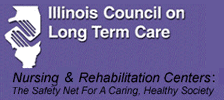|

July 20, 2000
Illinois Nursing Homes Rank #1 in Restoring Resident
Independence
(Chicago) -- According
to the latest statistics from the Health Care Financing
Administration (HCFA), Illinois nursing homes have the
highest national percentage of residents who are independent
in bathing, dressing, toileting, transferring, and walking
and have the second highest national percentage of residents
who are independent in eating (see enclosed bar graph).
These statistics reflect the state
of Illinois’ strong emphasis on providing residents
therapy, rehabilitation, and restorative care services.
The Illinois nursing home industry has one of the most
comprehensive care continuums of physical rehabilitation
in the nation. This care continuum has made a tremendous
impact on promoting resident independence and well-being.
In many states, when an elderly person
has completed therapy under Medicare, little is done
afterwards to reinforce the results of therapy. As a
result, the person either shows no continued improvement
over the next weeks or months or declines functionally.
In Illinois nursing homes, residents continue to receive
rehabilitation from the therapy department and restorative
care from the nursing department to supplement the work
of the initial therapy program.
In general, therapy
generally refers to intensive, short-term therapy to
help someone recover functionality from an acute illness
or accident and is usually covered under Medicare or
private insurance. Therapy generally involves a period
of one to four weeks.
Rehabilitation
refers to less-intensive, longer-term approaches to
maintain or slowly improve functional ability, conducted
by the therapy department.
Restorative
care refers to the same types of long-term approaches,
except that instead of being done by therapists, the
approaches are done on the living units by nurses and
nurse aides to reinforce the work of the therapy department.
At the heart of a restorative
care program is the integration of residents’ therapeutic
needs into their daily routines. For instance, a
resident may have the goal of walking more independently
and be involved in a Restorative Ambulation Program.
Following the directions of the facility’s
physical therapist, a nurse aide would have the resident
ambulate using a rolling walker every afternoon from
her room to the nurse’s station for medications.
The resident would use mealtime as an opportunity to
practice ambulation skills in walking with staff assistance
to the dining room. The goal is to combine rehabilitation
with activities of daily living to promote resident
independence.
During the late 1980’s, the
State of Illinois established a special 60-hour course
in rehabilitation for nurses, and a rehabilitation certificate
for nursing assistants to help keep residents’
muscles strong and flexible to maintain their mobility
and independence. Specially trained certified nurse
aides (CNAs) complete a three day course and must pass
a proficiency exam to become a physical or occupational
(PR, OR) rehab aides, working under the supervision
of a rehab nurse and/or licensed therapist to help residents’
achieve their therapeutic goals.
The State of Illinois is one of the
few states in the nation to have specialized training
programs in rehabilitation for nurses and nurse aides.
Most Illinois nursing facilities
employ these specially-trained nurses and nurse aides
to contribute their expertise in working hand-in-hand
with the therapy departments. The combination of therapists,
nurses, and nurses aides working together to maximize
resident functionality has proved to be very successful
in helping residents achieve excellent clinical outcomes,
as the state of Illinois’ statistics attest.
“Physical and occupational rehabilitation
programs have served as a great prototype in promoting
resident independence,” states Sandy Jacobson-Lerner,
President of Comprehensive Therapeutics, Ltd. “These
programs have worked to enhance the full continuum of
care, continuing to addressing residents’ functional
needs long after their days of therapy under Medicare
have run out.”
In addition, the State of Illinois
has also reinforced the importance of rehabilitation
through financial support. Back in the 1980’s,
the state developed a new reimbursement system for Public
Aid residents called the DPA
2700. The previous PH033 system only recognized
increased care costs as the resident’s condition
deteriorated. If a facility provided the extra resources,
services, and programs it takes to improve a resident’s
condition, under the old PH033 system, the facility
was rewarded with a lower reimbursement.
Under the DPA 2700 reform initiative,
funding was initiated for restorative and preventative
services, which
encouraged and rewarded functional and medical improvement
of the resident’s condition. Besides providing
a more independent, higher quality of life for the resident,
the Department actually saves money in not having to
reimburse for higher, sicker, more dependent levels
of care.
Statistics over the years have shown
that as rehabilitation and restorative care programs
have increased in Illinois nursing homes, the level
of resident independence has increased. “Greater
resident independence is a primary indicator for quality
care,” states Terry Sullivan, executive director
of the Illinois Council on Long Term Care, a nursing
home trade association. “Illinois’ strong
emphasis on rehabilitative and restorative care has
made a dramatic impact in providing greater quality
care, increasing resident independence and improving
resident quality of life.”
#
# #
Focus on Rehabilitation: The Changing Face of Illinois Nursing Homes
Over the last several years, there has been an increasing number
of patients receiving therapy and rehabilitation services
in a nursing home setting. Lengths of stays at hospitals
have decreased dramatically, leading to some patients
who normally would be receiving therapy and rehab services
in an acute care setting receiving these services in
a long term care environment. Reflecting this change
in treatment focus, many nursing facilities have changed
their names from “Nursing Home” to “Healthcare
and Rehabilitation Center.”
Improvements in medical technology
now permit complex monitoring and care to be administered
outside hospitals. In addition, patients and physicians
are becoming more comfortable with receiving and providing
medical care in non-acute settings.
Nursing homes have responded by developing
intensive therapy and rehab programs that have proven
to be very successful in helping patients optimize their
functional abilities. Many nursing facilities have their
own physical, occupational and speech therapists on
staff and have fully equipped therapy rooms with state-of-the-art
rehabilitation equipment, such as the Nautilus equipment
used at Bloomingdale Pavilion (see enclosed resident
story).
Increasingly, patients are coming
to nursing homes for short-term stays, often for a period
of 1-4 weeks, receiving intensive therapy and rehabilitation
before being discharged for home. Many younger patients,
including individuals in their 30’s, 40’s,
and 50’s, are now receiving their needed therapy
in a long term care setting before returning to the
community.
Many Illinois nursing facilities
offer subacute care which is a transitional level
of service for patients whose treatment needs fall between
those provided in an acute hospital setting and a traditional
skilled nursing environment. Patients entering a subacute
program are usually stable and no longer require the
treatment provided early in the acute episode or injury;
however, they still need 24 hour professional care.
The care regimen for subacute patients
can vary greatly from that of traditional geriatric
patients. For example, subacute patients may require
three to five physician visits per week; four to eight
nursing hours per patient day; ongoing therapists to
ensure continuity of care; and prearranged provision
of outside medical and ancillary services. Subacute
units generally feature 24 hour admissions policies;
full-time rehabilitation services; increased pharmacy
availability; higher nursing to patient ratios, greater
physician involvement, and a strong quality assurance
program with measurable outcome data.
Subacute care encompasses a wide
range of diagnostic categories that go far beyond the
typical diagnoses found in a geriatric setting. A subacute
unit can include patients who have suffered from brain
injuries, spinal cord injuries, cardiac problems, neuromuscular
impairments, and musculo-skeletal problems. The focus
of care is helping these individuals regain their functional
independence and medical well-being in the shortest
period of time so that they can successfully return
to the community.
#
# #
Innovations in Promoting Independence: Strength Training Equipment
Helps
Bedridden Resident Regain the Ability to Walk
When Agnes Brown came to Bloomingdale
Pavilion Nursing Facility last January, she hadn’t
walked in three years. A triple by-pass, knee replacement
surgery and diabetes had left Agnes primarily bedridden
and dependent on her motorized wheelchair. Eight weeks
later, Agnes got up out of her wheelchair and danced
the polka.
Agnes’ functional independence
reflects her participation in the Restore
Program, a powerful new rehabilitation and fitness
program that uses state-of-the-art Nautilus strength-building
equipment with people recovering from surgery, strokes,
or heart attacks. The program’s equipment has been
designed with features specifically for the older person
-- reduced weight stacks, resistance controls allowing
weight increases as small as eight ounces, range of
motion limiting devices and specialized ergonomic design.
Agnes participated in the Restore
program three times a week, working with a physical
therapist to gradually strengthen her legs and build
up her endurance. Says Agnes, “I’ve been a
ballroom dancer all my life. One night I couldn’t
bear just sitting and listening to the music at the
weekly polka party anymore. Rose, the activities instructor,
came up to me and said, `Come on. Give it a try.’
I thought, `Oh my God. I’d love to. Just hang on
to me.’ I hadn’t used my legs in three years.
And we danced. I was so excited. I called my daughter
right away and invited her to the next polka party.”
“My mom called me one day and
said `Can you reserve March 14? I’m having a polka
party. I want to show you how I can dance’.”
states Cindy Menick, Agnes’ daughter. “That
night I went to the nursing home. Rose came up to my
mother and helped her out of the wheelchair. They danced
two whole dances. I just sat there and cried my eyes
out.”
“Working with the Nautilus equipment
has made a huge difference with Mom,” Cindy adds.
“Now she can visit me at my house. She can get
in and out of my car and walk into my house using a
walker.”
Agnes continues to use the strength-building
equipment twice a week with the assistance of an aide.
Each week she increases her repetitions and weight.
“I love using the equipment,” Agnes points
out. “It’s given me a whole new outlook on
life. For three years I couldn’t use my legs. Now
I can. And, I’m not done yet,” adds Agnes.
Agnes’ story reflects the efforts
of many Illinois nursing facility professionals who
have dedicated themselves to maximizing their residents’
functional independence. These staff members have utilized
therapy, rehabilitation and restorative programs to
make a profound effect not only on these individuals’
physical well-being, but also their morale, outlook,
and self-esteem.
# # #

|

